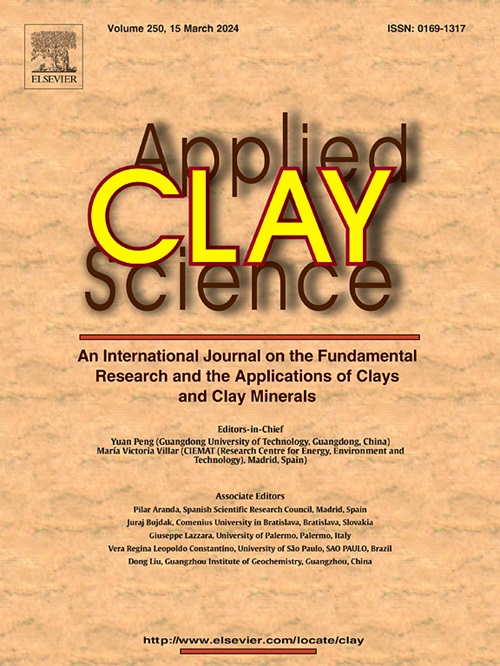Effects of silicas and aluminosilicate synthesized by sol-gel process on the structural properties of metakaolin-based geopolymers
IF 5.3
2区 地球科学
Q2 CHEMISTRY, PHYSICAL
引用次数: 0
Abstract
This study synthesized two silicas and an aluminosilicate (AlS, Al2O3.2SiO2) via the sol-gel process to evaluate their effects on metakaolin-based geopolymers. Two geopolymer dosages were prepared with metakaolin and 0, 1, 2, and 10 %wt. sol-gel materials, using metakaolin and silica-rich byproducts (rice husk ash and silica fume) as references. The results revealed that sol-gel silicas above 2 %wt. led to particle aggregation and alkalis entrapment, worsening efflorescence. Geopolymers with 10 % sol-gel silicas exhibited 3-day compressive strengths of approximately 10 MPa, compared to ∼35 MPa for geopolymers with 10 % sol-gel aluminosilicate or pure metakaolin. This indicates that AlS particles dissolved more readily during geopolymerization, forming binder structures at early ages. Furthermore, AlS-based structures inhibited Na+ diffusion in the hardened matrix, reducing efflorescence compared to reference samples. However, this effect was less noticeable at the more porous dosage of geopolymers. AlS-derived structures were more porous than the metakaolin-based structures, limiting strength gain up to 28 days.

溶胶-凝胶法制备二氧化硅和硅酸铝对偏高岭土聚合物结构性能的影响
本研究采用溶胶-凝胶法合成了两种二氧化硅和一种铝硅酸盐(al, Al2O3.2SiO2),并评价了它们对偏高岭土基地聚合物的影响。用偏高岭土和0、1、2和10% wt配制了两种地聚合物剂量。溶胶-凝胶材料,使用偏高岭土和富含二氧化硅的副产品(稻壳灰和硅灰)作为参考。结果表明,溶胶-凝胶二氧化硅在2% wt以上。导致颗粒聚集和碱夹持,使花期恶化。含有10%溶胶-凝胶二氧化硅的地聚合物显示出3天的抗压强度约为10 MPa,而含有10%溶胶-凝胶铝硅酸盐或纯偏高岭土的地聚合物则为~ 35 MPa。这表明al颗粒在地聚合过程中更容易溶解,在早期形成粘结剂结构。此外,与参考样品相比,基于als的结构抑制了Na+在硬化基体中的扩散,减少了荧光。然而,这种效果在更多孔的地聚合物剂量下不太明显。als衍生的结构比偏高岭土结构更多孔,限制了28天的强度增加。
本文章由计算机程序翻译,如有差异,请以英文原文为准。
求助全文
约1分钟内获得全文
求助全文
来源期刊

Applied Clay Science
地学-矿物学
CiteScore
10.30
自引率
10.70%
发文量
289
审稿时长
39 days
期刊介绍:
Applied Clay Science aims to be an international journal attracting high quality scientific papers on clays and clay minerals, including research papers, reviews, and technical notes. The journal covers typical subjects of Fundamental and Applied Clay Science such as:
• Synthesis and purification
• Structural, crystallographic and mineralogical properties of clays and clay minerals
• Thermal properties of clays and clay minerals
• Physico-chemical properties including i) surface and interface properties; ii) thermodynamic properties; iii) mechanical properties
• Interaction with water, with polar and apolar molecules
• Colloidal properties and rheology
• Adsorption, Intercalation, Ionic exchange
• Genesis and deposits of clay minerals
• Geology and geochemistry of clays
• Modification of clays and clay minerals properties by thermal and physical treatments
• Modification by chemical treatments with organic and inorganic molecules(organoclays, pillared clays)
• Modification by biological microorganisms. etc...
 求助内容:
求助内容: 应助结果提醒方式:
应助结果提醒方式:


